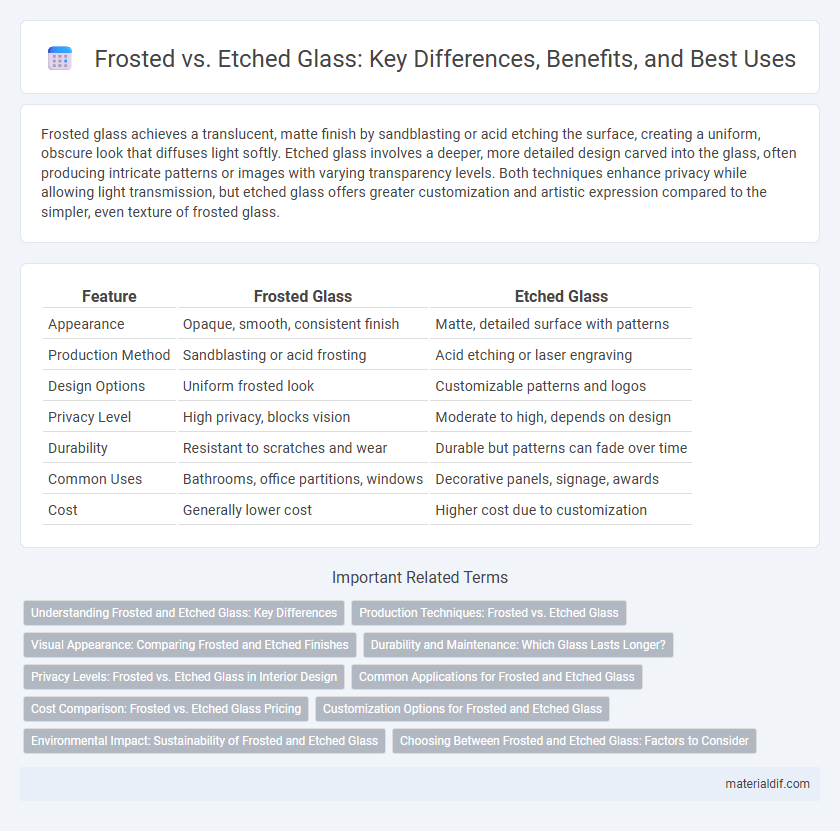Frosted glass achieves a translucent, matte finish by sandblasting or acid etching the surface, creating a uniform, obscure look that diffuses light softly. Etched glass involves a deeper, more detailed design carved into the glass, often producing intricate patterns or images with varying transparency levels. Both techniques enhance privacy while allowing light transmission, but etched glass offers greater customization and artistic expression compared to the simpler, even texture of frosted glass.
Table of Comparison
| Feature | Frosted Glass | Etched Glass |
|---|---|---|
| Appearance | Opaque, smooth, consistent finish | Matte, detailed surface with patterns |
| Production Method | Sandblasting or acid frosting | Acid etching or laser engraving |
| Design Options | Uniform frosted look | Customizable patterns and logos |
| Privacy Level | High privacy, blocks vision | Moderate to high, depends on design |
| Durability | Resistant to scratches and wear | Durable but patterns can fade over time |
| Common Uses | Bathrooms, office partitions, windows | Decorative panels, signage, awards |
| Cost | Generally lower cost | Higher cost due to customization |
Understanding Frosted and Etched Glass: Key Differences
Frosted glass features a uniformly textured surface created by sandblasting or acid etching, providing a translucent effect that obscures visibility while allowing light to pass through. Etched glass involves a more intricate decorative process using acid to create detailed designs or patterns on clear glass without fully obscuring light transmission. Understanding these differences helps in choosing the right type of glass for privacy, aesthetics, or light diffusion in architectural and interior design applications.
Production Techniques: Frosted vs. Etched Glass
Frosted glass is created through acid etching or sandblasting, producing a uniform, translucent surface that diffuses light while maintaining privacy. Etched glass uses a chemical or laser process to carve intricate designs or patterns into the surface, offering detailed artistic effects. Both techniques alter the glass's surface texture but differ in precision and visual complexity, influencing the choice based on design and functional requirements.
Visual Appearance: Comparing Frosted and Etched Finishes
Frosted glass features a uniform, matte surface created by sandblasting or acid etching, resulting in a smooth, translucent appearance that softly diffuses light. Etched glass offers more intricate and detailed designs, achieved through chemical treatment or laser engraving, providing a textured and decorative finish with varying levels of opacity. Both finishes enhance privacy while adding aesthetic appeal, but frosted glass tends to deliver a consistent glow, whereas etched glass emphasizes artistic patterns and depth.
Durability and Maintenance: Which Glass Lasts Longer?
Frosted glass, created by sandblasting or acid etching, offers solid durability with a consistent matte finish that resists scratches and minor damage over time. Etched glass features intricate patterns carved into the surface, which may collect dirt and require more careful cleaning to maintain clarity and detail. Overall, frosted glass tends to last longer and demands less maintenance due to its uniform texture and resistance to wear.
Privacy Levels: Frosted vs. Etched Glass in Interior Design
Frosted glass offers higher privacy levels by diffusing light and obscuring visibility, making it ideal for bathrooms and conference rooms where discretion is essential. Etched glass provides a more subtle translucency with decorative patterns that partially obscure sight, balancing privacy and aesthetic appeal. Both options enhance privacy but vary in opacity and texture, influencing their suitability in different interior design applications.
Common Applications for Frosted and Etched Glass
Frosted glass is commonly used in bathroom windows, shower enclosures, and office partitions to provide privacy while allowing natural light to pass through. Etched glass often appears in decorative panels, glass doors, and signage, offering intricate designs and a textured aesthetic. Both types enhance privacy and style but are chosen based on the desired visual effect and application.
Cost Comparison: Frosted vs. Etched Glass Pricing
Frosted glass typically costs less than etched glass due to the simpler manufacturing process involving acid etching or sandblasting to create a translucent surface. Etched glass often requires more detailed craftsmanship or laser engraving, increasing production time and expenses, which drives up its price. Businesses and homeowners choosing between frosted and etched glass should weigh the budget differences alongside their design preferences and installation complexity.
Customization Options for Frosted and Etched Glass
Frosted glass offers extensive customization options including varying levels of opacity, color tints, and the ability to create intricate patterns through sandblasting or acid etching techniques. Etched glass provides precise, detailed designs with high durability, often used for logos, text, and decorative motifs through controlled chemical or laser etching processes. Both methods allow for tailored aesthetic effects to enhance privacy, light diffusion, and interior design elements.
Environmental Impact: Sustainability of Frosted and Etched Glass
Frosted glass typically involves sandblasting or acid etching, with the latter often using chemicals that may pose environmental risks if not properly managed. Etched glass created through acid etching can generate hazardous waste requiring specialized disposal, whereas mechanical methods like sandblasting for frosted finishes tend to have a lower environmental footprint. Selecting frosted glass with eco-friendly processes contributes to sustainability by reducing chemical usage, energy consumption, and waste production during manufacturing.
Choosing Between Frosted and Etched Glass: Factors to Consider
Choosing between frosted and etched glass depends on factors such as desired privacy level, aesthetic appeal, and maintenance needs. Frosted glass offers a uniform, matte finish providing consistent privacy and easier cleaning, while etched glass features detailed, artistic patterns that enhance design but may require more upkeep. Consider the project's style, light diffusion preference, and durability requirements to select the optimal glass type.
Frosted vs Etched Infographic

 materialdif.com
materialdif.com